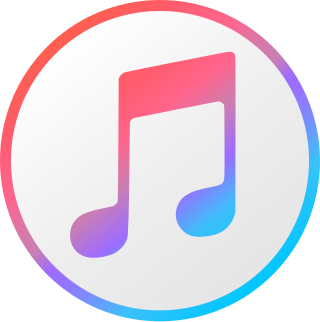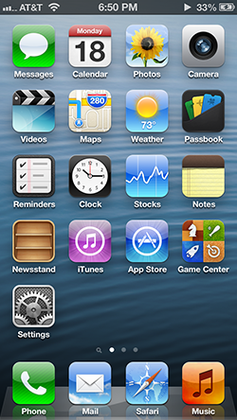
iTunes is a discontinued media player, media library, and mobile device management utility developed by Apple. It was used to purchase, play, download and organize digital multimedia on personal computers running the macOS and Windows operating systems, and can be used to rip songs from CDs as well as playing content from dynamic, smart playlists. It includes options for sound optimization and wirelessly sharing iTunes libraries.

Keynote is a presentation software application developed as a part of the iWork productivity suite by Apple Inc. Version 10 of Keynote for Mac, the latest major update, was released in March 2020. On January 27, 2010, Apple announced a new version of Keynote for iPad with an all-new touch interface. It is now also available for the iPhone to download from the App Store.

iWork is an office suite of applications created by Apple for its macOS, iPadOS, and iOS operating systems, and also available cross-platform through the iCloud website.

Pages is a word processor developed by Apple Inc. It is part of the iWork productivity suite and runs on the macOS, iPadOS, and iOS operating systems. It is also available on iCloud on the web. The first version of Pages was released in February 2005. Pages is marketed by Apple as an easy-to-use application that allows users to quickly create documents on their devices. Many Apple-designed templates comprising different themes are included with Pages.

The iTunes media platform was first released by Apple in 2001 as a simple music player for Mac computers. Over time, iTunes developed into a sophisticated multimedia content manager, hardware synchronization manager and e-commerce platform. iTunes was finally discontinued for new Mac computers in 2019, but is still available and supported for Macs running older operating systems and for Windows computers to ensure updated compatibility for syncing with new releases of iOS devices.

Apple TV is a digital media player and microconsole developed and marketed by Apple. It is a small piece of networking hardware that sends received media data such as video and audio to a TV or external display. Its media services include streaming media, TV Everywhere-based services, local media sources, and sports journalism and broadcasts.

djay is a digital music mixing software program for Mac OS X, Microsoft Windows, iPad, iPhone, and iPod Touch created by the German company algoriddim. It allows playback and mixing of digital audio files with a user interface that tries to simulate the concept of "two turntables and a microphone" on a computer. Before the commercial release in November 2007, djay had initially been released as freeware in June 2006. In December 2010 the software was also released for the iPad, and subsequently for iPhone and iPod Touch in March 2011.

The iPod Touch is a discontinued line of iOS-based mobile devices designed and formerly marketed by Apple Inc. with a touchscreen-controlled user interface. As with other iPod models, the iPod Touch can be used as a portable media player and a handheld gaming device, but can also be used as a digital camera, a web browser, for email and messaging. It is nearly identical in design to the iPhone, and can run most iPhone third-party apps from the App Store, but it connects to the Internet only through Wi-Fi and uses no cellular network data, as it lacks a cellular modem.

iOS is a mobile operating system developed by Apple exclusively for its smartphones. It was unveiled in January 2007 for the first-generation iPhone, launched in June 2007.
iOS jailbreaking is the use of a privilege escalation exploit to remove software restrictions imposed by Apple on devices running iOS and iOS-based operating systems. It is typically done through a series of kernel patches. A jailbroken device typically permits root access within the operating system and provides the right to install software unavailable through the App Store. Different devices and versions are exploited with a variety of tools. Apple views jailbreaking as a violation of the end-user license agreement and strongly cautions device owners not to try to achieve root access through the exploitation of vulnerabilities.

AirPlay is a proprietary wireless communication protocol stack/suite developed by Apple Inc. that allows the streaming of multimedia and device screens, together with related metadata, between compatible devices. Originally implemented only in Apple's own software and hardware, the company has since licensed the AirPlay protocol stack to third-party manufacturers and it has been implemented on devices such as television sets and home audio systems. AirPlay works through either a direct peer-to-peer connection between devices or through an infrastructure local network.

iOS 6 is the sixth major release of the iOS mobile operating system developed by Apple Inc, being the successor to iOS 5. It was announced at the company's Worldwide Developers Conference on June 11, 2012, and was released on September 19, 2012. It was succeeded by iOS 7 on September 18, 2013.

iPhone OS 3 is the third major release of the iOS mobile operating system developed by Apple Inc., succeeding iPhone OS 2. It was announced on March 17, 2009, and was released on June 17, 2009. It was succeeded by iOS 4 on June 21, 2010, dropping the "iPhone OS" naming convention.

HomeKit, also known as Apple Home, is a software framework and communication protocol developed by Apple Inc. that lets users configure, communicate with and control smart-home appliances using Apple devices. It provides users with a way to automatically discover such devices and configure them. By designing rooms, items and actions in HomeKit, users can enable automations in the home through a voice command to Siri or through the Home app or third party apps. With HomeKit, developers are able to create complex applications in order to manage accessories at a high level.

tvOS is an operating system developed by Apple Inc. for the Apple TV, a digital media player. In the first-generation Apple TV, Apple TV Software was based on Mac OS X. Starting with the second generation, the software is based on the iOS operating system and has many similar frameworks, technologies, and concepts.

myTuner Radio, or simply myTuner, is an Internet radio app directory/platform owned by AppGeneration – Software Technologies, Lda, a development company based in Porto, Portugal founded by Eduardo Carqueja in October 2010. myTuner Radio has over 50,000 radio stations and one million podcasts from all around the world. On June 7, 2017, AppGeneration announced that its service had over 30 million users and a database with radio stations of 200 countries. my Turner Radio platform is available for the web at mytuner-radio.com, for a suite of mobile apps: iOS, Google Play, Samsung, Huawei, Amazon, Windows Phone; for desktop devices: Web, Windows, and Mac, wearables: Apple Watch and Android Wearables, for connected devices like Apple TV, Samsung TVs, LG TVs, TV sets and set-top boxes with Android TV, Amazon Fire TV, Roku TV and Chromecast, connected cars: Apple Carplay, Android Auto, Bosch mySPIN, Jaguar & Land Rover InControl Apps, and also on home appliances and smart speakers like Alexa and Sonos.

iOS 13 is the thirteenth major release of the iOS mobile operating system developed by Apple for the iPhone, iPod Touch and HomePod. The successor to iOS 12, it was announced at the company's Worldwide Developers Conference (WWDC) on June 3, 2019, and released on September 19, 2019. It was succeeded by iOS 14, released on September 16, 2020.

Music is a media player application developed for the iOS, iPadOS, macOS, watchOS, visionOS, tvOS, Android, and Windows operating systems by Apple Inc. It can play music files stored locally on devices, as well as stream from the iTunes Store and Apple Music.
iPadOS is a mobile operating system for tablet computers developed by Apple Inc. It was first released as a modification of iOS starting with version 13.1 on September 24, 2019. Before the release of iPadOS, iPads were released with iPhone OS, which was later renamed to iOS. New iPadOS versions are released every year mostly in sync with iOS, tvOS, and watchOS.















